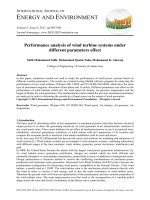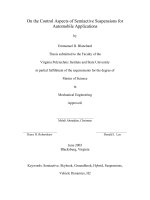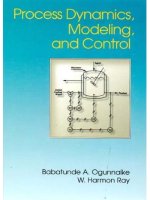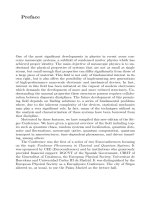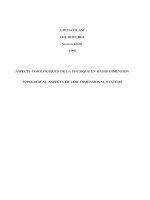MODELING AND CONTROL ASPECTS OF WIND POWER SYSTEMS doc
Bạn đang xem bản rút gọn của tài liệu. Xem và tải ngay bản đầy đủ của tài liệu tại đây (17.03 MB, 212 trang )
MODELING AND
CONTROL ASPECTS OF
WIND POWER SYSTEMS
Edited by S. M. Muyeen, Ahmed Al-Durra
and Hany M. Hasanien
Modeling and Control Aspects of Wind Power Systems
/>Edited by S. M. Muyeen, Ahmed Al-Durra and Hany M. Hasanien
Contributors
Alfeu J. Sguarezi Filho, Carlos Capovilla, Ivan Casella, Ernesto Ruppert, Hilton Abílio Gründling, Ivan Gabe, Humberto
Pinheiro, Tamer Kawady, Ahmed Nahhas, Roberto Daniel Fernandez, Ricardo Mantz, Pedro Battaiotto, César Angeles-
Camacho, Claudio Ruben Fuerte-Esquivel, Esher Barrios-Martinez, Luis M. Castro, Ahmed Abo-Khalil, Tárcio Barros,
Francisco Bañuelos-Ruedas, Guillermo Romo-Guzmán, Manuel Reta-Hernández, S. M. Muyeen
Published by InTech
Janeza Trdine 9, 51000 Rijeka, Croatia
Copyright © 2013 InTech
All chapters are Open Access distributed under the Creative Commons Attribution 3.0 license, which allows users to
download, copy and build upon published articles even for commercial purposes, as long as the author and publisher
are properly credited, which ensures maximum dissemination and a wider impact of our publications. After this work
has been published by InTech, authors have the right to republish it, in whole or part, in any publication of which they
are the author, and to make other personal use of the work. Any republication, referencing or personal use of the
work must explicitly identify the original source.
Notice
Statements and opinions expressed in the chapters are these of the individual contributors and not necessarily those
of the editors or publisher. No responsibility is accepted for the accuracy of information contained in the published
chapters. The publisher assumes no responsibility for any damage or injury to persons or property arising out of the
use of any materials, instructions, methods or ideas contained in the book.
Publishing Process Manager Dimitri Jelovcan
Technical Editor InTech DTP team
Cover InTech Design team
First published March, 2013
Printed in Croatia
A free online edition of this book is available at www.intechopen.com
Additional hard copies can be obtained from
Modeling and Control Aspects of Wind Power Systems, Edited by S. M. Muyeen, Ahmed Al-Durra
and Hany M. Hasanien
p. cm.
ISBN 978-953-51-1042-2
free online editions of InTech
Books and Journals can be found at
www.intechopen.com
Contents
Preface VII
Chapter 1 Dynamic Characteristics Analysis of Wind Farm Integrated
with STATCOM Using RTDS 1
Adnan Sattar, Ahmed Al-Durra and S.M. Muyeen
Chapter 2 Wireless Coded Deadbeat Power Control for Wind Energy
Generation 19
C. E. Capovilla, A. J. Sguarezi Filho, I. R. S. Casella and E. Ruppert
Chapter 3 Direct Power Control for Switched Reluctance Generator in
Wind Energy 39
Tárcio A. dos S. Barros, Alfeu J. Sguarezi Filho and Ernesto Ruppert
Filho
Chapter 4 Wind Turbines Reactive Current Control During Unbalanced
Voltage Dips 61
Ivan Jorge Gabe , Humberto Pinheiro and Hilton Abílio Gründling
Chapter 5 Wind Farms as Negative Loads and as Conventional
Synchronous Generation – Modelling and Control 85
Roberto Daniel Fernández, Pedro Eugenio Battaiotto and Ricardo
Julián Mantz
Chapter 6 An Integrated Power Flow Solution of Flexible AC Transmission
Systems Containing Wind Energy Conversion Systems 117
E. Barrios-Martinez, L.M. Castro, C.R. Fuerte-Esquivel and C.
Angeles-Camacho
Chapter 7 Impacts of Wind Farms on Power System Stability 133
Ahmed G. Abo-Khalil
Chapter 8 Modeling Issues of Grid-Integrated Wind Farms for Power
System Stability Studies 153
Tamer A. Kawady and Ahmed M. Nahhas
Chapter 9 Study for Wind Generation and CO2 Emission Reduction
Applied to Street Lighting – Zacatecas, México 189
Francisco Bañuelos-Ruedas, César Ángeles-Camacho, Guillermo
Romo-Guzmán and Manuel Reta-Hernández
ContentsVI
Preface
The present trend is to boost up the renewable energy penetration rate in the existing power
systems. Among the renewable energy sources such as wind, solar, biogas/biomass, tidal,
geothermal, etc., wind energy has the huge potential to compete with the conventional ener‐
gy sources. As a result, the research on wind power is progressing drastically. The research
requires the involvement from many engineering and science disciplines, e.g., mechanical,
electrical, electronics, computer, and aerospace engineering. Each of the fields is unique,
awesome, and has its own beauty. The joint effort from different fields has brought this tech‐
nology to a mature level.
This book is a result of inspiration and contribution of many researchers from different fields
and a wide variety of research results are merged together to make this book useful for stu‐
dents and researchers. In our capacity as the editors of this book, we would like to thank the
authors for ensuring that the quality of the material is at the highest level. Some of the results
presented in this book have already been published or presented at different international
journals and conferences to a certain extent and a large number of individuals and organiza‐
tions has extended their support to the authors in different ways, and we would like to take the
opportunity to thank them for their cordial cooperation. The editors would also like to thank
Mr. Dimitri Jelovcan for his continuous support in the editorial process. We hope you will
enjoy the book so that our efforts in bringing it together are meaningful.
S. M. Muyeen
Electrical Engineering Department
The Petroleum Institute
Abu Dhabi, U.A.E.
Ahmed Al-Durra
Electrical Engineering Department
The Petroleum Institute
Abu Dhabi, U.A.E.
Hany M. Hasanien
Electrical Engineering Department
King Saud University
Riyadh, Saudi Arabia
Chapter 1
Dynamic Characteristics Analysis of
Wind Farm Integrated with STATCOM Using RTDS
Adnan Sattar, Ahmed Al-Durra and S.M. Muyeen
Additional information is available at the end of the chapter
/>1. Introduction
This work concentrates on design and analysis of STATCOM connected at the wind farm
terminal in real time environment using Real Time Digital Simulator (RTDS). This work is a
part of power hardware-in-loop (PHIL) test required in a future project, and therefore,
individual components are models in such a way that is close to real system. For the sake of
detail analyses and future study, the system is simulated in two ways. First method is a dual
time step approach, where wind turbines and generators of a wind farm, power grid, and
control system are realized in the large time-step main network, however, 2-level voltage
source converter based STATCOM is modeled in RTDS small time-step environment to adapt
with higher switching frequency, where interface transformer is used to link the different time
step sub-networks. In the second method, the entire system including the STATCOM is
simulated in large time step. Detailed switching scheme for STATCOM and control strategy
for both methods are discussed. An option for integrating anemometer for dynamic charac‐
teristics analysis is kept open, difficulties of STATCOM switching schemes for control
prototype and PHIL testing in RTDS environment are discussed. The merits and demerits of
both methods are also presented which is one of the salient features of this study. Results of
RTDS are compared with Laboratory standard power system software PSCAD/EMTDC and
the features of using RTDS in dynamic characteristics analyses of wind farm are also discussed.
2. Real Time Digital Simulator (RTDS) — A brief overview
2.1. Hardware
Real time digital simulator hardware is based on the parallel processing architecture and has
been designed specially to solve the electromagnetic transient simulation algorithm. RTDS
© 2013 Sattar et al.; licensee InTech. This is an open access article distributed under the terms of the Creative
Commons Attribution License ( which permits unrestricted use,
distribution, and reproduction in any medium, provided the original work is properly cited.
simulator consists of multiple RACKs, each of which consist of both communication and
processor cards and are linked by a common backplane. To solve a large power system
network, it is possible to split the entire power system into parts and these parts can be solved
on the different subsystems or even using different racks on the RTDS simulator. Each rack
has an Inter Rack Communication (IRC) card which allows the information to be shared
between the different racks of RTDS. This study is carried out on RTDS consist of 3 RACKs.
Each rack has also a Workstation Interface (WIF) card which synchronizes the simulation
calculations and communicates between different processor cards, as well as communication
between different racks of the RTDS simulator. Also WIF card provides Ethernet communi‐
cation to and from the graphical user interface during real time simulation.
The processors cards are responsible for the calculation of complete network behavior. RTDS
uses two different processor card, 3PC (Processor card) and GPC (Gigabyte processor card).
GPC contains 2 RISC processors running at 1GHz. Due to their computational power, they are
often used in more than one component model calculation at the same time. It is noted that
PB5 processor card, the next generation of GPC card is available in market from 2011, which
has additional computation power and communication flexibility. Besides that, RTDS has a
family of GT I/O cards. They are used with the GPC cards. GT I/O cards include analogue and
digital input and output with 16-bit data converters. Other physical devices can be connected
to the RTDS hardware by GT I/O cards.
2.2. Software
The graphical user interface between RTDS hardware and user is done by its own software,
called RSCAD. It allows simulation circuit to be constructed, run, operated and results to be
recorded. The RSCAD has 2 main modules, the Draft and the Run time. In Draft, an extensive
library for both power system and control system components is available. The circuit can be
constructed by copying the generic components from the library. After completion of the
circuit, it will be complied in order to create the simulation codes required by the RTDS
simulator. The simulation can be run using RSCAD Run Time module. Run time, operates on
a PC or on workstation, back and forth communication with the WIF card through Ethernet.
Simulation result can be plotted and operating condition of the system can be changed in run
time by using switches, push buttons, etc., like the real world electric control rooms. A special
module exists in RSCAD, so called T-LINE module, facilitate entry of transmission line data.
Input information is related to the line geometry and conductor type. Multi-plot is used to
analyze the graphical results and also to prepare it in report ready format. Several functions
are available e.g., Fourier analysis and Total Harmonic Distortion computation. Figure 1 and
2 shows the RTDS hardware and RSCAD software modules [1-4].
3. Model system
The model system used for the simulation is shown in Figure 3. Aggregated model of the wind
farm is considered in this study in which many wind generators in a wind farm are represented
Modeling and Control Aspects of Wind Power Systems
2
with a large wind generator. The induction generator is connected to the grid through the step
up transformer and double circuit transmission line. Realistic data for the transmission line is
used which is calculated from the transmission line length. As transmission line length is very
important because of the STATCOM voltage support set point is considered at the common
coupling point [5].
Figure 1. Real Time Digital Simulator (RTDS) Racks Installed in Electrical Department, The Petroleum Institute.
Dynamic Characteristics Analysis of Wind Farm Integrated with STATCOM Using RTDS
/>3
Figure 2.
(a)
(b)
(c)
Figure 2. (a): RSCAD Software Modules. (b): Draft Module. (c): Run Time Module.
Modeling and Control Aspects of Wind Power Systems
4
50 Hz, 10 MVA Base
IG
STATCOM
Wind Turbine
Induction
Generator
DC Link
PCC
Z1= 0.05+j0.3
pu
Z2= 0.05+j0.3 pu
InfiniteBus
CB CB
CB CB
66/3.3 KV,
10 MVA,
X=0.1
R
e
a
c
t
i
v
e
P
o
w
e
r
o
f
t
h
e
S
T
A
T
C
O
M
Real Power of the IG
0.69/ 66 KV
10 MVA, X=0.1
3 LG Fault
Figure 3. Fixed speed WTGSs including STATCOM connected at the PCC.
4. Real time simulation setup
Figure 4 shows the real time simulation setup required for this study. As discussed earlier,
RTDS can be connected with other physical devices, an anemometer is considered to measure
the wind speed data from the real site which will be sent to the RTDS via GT I/O cards. The
wind speed signal will then be sent to RSCAD environment though workstation interfacing
card and will be used in wind turbine model to produce torque for wind generator. Hence,
this is the most accurate way of analyzing the behavior of wind turbine generator behavior at
different operating conditions.
Figure 5 shows the RSCAD model system. The Induction machine is driven by the fixed wind
turbine and is connected to the electric grid through the step up transformer and double circuit
transmission line. The STATCOM is connected at the high voltage side of the transformer.
Dynamic Characteristics Analysis of Wind Farm Integrated with STATCOM Using RTDS
/>5
Real Time Digital Simulator (RTDS)
Graphical User
Interface/RSCAD
Draft Module
Signals To and From
GT-I/O card
Real Wind Velocity signals
GT I/O Card
Anemometer
RunTime module
Figure 4. Real time simulation block diagram.
Figure 5. Fixed speed WTGSs including STATCOM connected at the PCC.
5. Modeling Of STATCOM
The modeling of STATCOM is completely done in the RTDS environment in two different
methods, one in the dual time-step approach and second in the large time-step approach of
the RSCAD. The details of both methods are presented in the following sub-sections.
5.1. VSC large time-step modeling of the STATCOM in RTDS
The power system components and control system components are modeled in the large time-
step environment. Large time-step network solution is 50 µsec. STATCOM is also modeled in
Modeling and Control Aspects of Wind Power Systems
6
the large time-step environment and then coupled with the rest of the system through the
transformer at PCC. Figure 6 shows the RTDS modules and processor assignments in large
time-step approach. The power system components are solved on the 3PC card, while the
control block is solve on the GPC card. GTO model is computed on the 3PC card. The switching
is done on the GPC card.
5.2. Switching scheme in large time-step
For the large time-step, switching is done by using the pulse width modulation (PWM)
technique. For GTO model, switching signal can be generated in two ways either by using one
6P Grp which will generate 6−bit firing pulse integer word (FP), one active bit integer word
(FLAST) or by 3 LEG mode. In 3 LG mode, there is one 2-bit firing pulse word, one active bit
word and one fraction word for each separate leg in the valve group. In this work, switching
is done by using 3 LEG mode. The switching diagram is shown in the Figure 7.
Power Electronics
Controller
GPC
Large Time Step
Switching Pulses/carrier
wave signal/valve
blocking Control 3PC
Large Time Step GPC
Switching freq 450Hz
STATCOM
3PC
Pitch
Control 3PC
Wind
Turbine
3PC
SCIG 3PC
Power System
network 3PC
LARGE TIME-STEP NETWORK
Figure 6. RTDS modules and processor in large time-step approach.
Dynamic Characteristics Analysis of Wind Farm Integrated with STATCOM Using RTDS
/>7
Switching Pulses
Grid Side Connection
Figure 7. Switching scheme for STATCOM in large time-step approach.
5.3. VSC dual time-step modeling of the STATCOM in RTDS
In this thesis, the STATCOM model is also developed in the small time-step environment of
the RTDS. Power system components and control system components are modeled in the large
time-step environment. Thus model system is run in two different time step, small time-step
normally run at 1µsec – 4µsec and large time-step typically running at 50µsec. Thus two
different time-step simulation is interfaced each other through the interface transformer. RTDS
modules and the processor assignments have been shown in Figure 8. Main power system
components are solved on the 3PC card. The STATCOM has been modeled in the Voltage
Source Converter (VSC) small time-step network, which are solved on the GPC card. The
control part is solved on the 3PC card. Carrier wave signal is generated in the large time-step
and are imported in the small time-step after being adapted with small-time step. The carrier
wave frequency is chosen 2 kHz.
5.4. Switching scheme in dual time-step
As mentioned earlier that dual time-step operates in both small and large time steps. Small
time-step VSC sub-network model including switching scheme is shown in Figure 9. Using
Modeling and Control Aspects of Wind Power Systems
8
the principal of pulse width modulation scheme, the carrier and modulation signals are
generated in the RTDS large time-step size environment and then processed to generate high
resolution firing pulses using the RTDS firing pulse generator component in the small time-
step environment. In order to ensure accurate firing this component requires the transfer of
reference phase and frequency from the large time-step environment. This allows the compo‐
nent to extrapolate the phase between large time-steps. The valves of the GTO bridge gets
firing pulse input from the comparator by selecting the option CC_WORD of GTO bridge. The
valves of the GTO bridge are controlled by the respected bits in a firing pulse word. These
consecutive bits are aligned in such a way that the least significant bit (LSB) in the firing pulse
coincide with the LSB in the final applied firing pulse word. Hence, the first LSB controls the
valve 1, the second LSB controls the valve 2, and so on [6-7].
Pitch
Control 3PC
Wind
Turbine
3PC
SCIG 3PC
Power network
3PC
Large time step Network
Interface
Transformer
STATCOM
GPC
VSC Small Time Step Network
Power Electronics
Controller
3PC
Large Time Step
Switching Pulses/carrier
wave signal/valve
blocking Control 3PC
Large Time Step
Switching freq 2KHz
Figure 8. RTDS modules and processor in dual time-step approach.
Dynamic Characteristics Analysis of Wind Farm Integrated with STATCOM Using RTDS
/>9
Figure 9. Switching scheme for STATCOM in small time-step VSC sub-network (part of dual time step approach).
6. STATCOM control strategy
The cascaded vector control scheme is considered for the control of the STATCOM, in this
study. The control block diagram of VSC based two level STATCOM is shown in Figure 10.
The aim of the control is to maintain desired voltage magnitude at the wind farm terminals
during normal operating condition and recover the voltage in shortest possible time after
occurrence of grid fault. The current signals are measured at the high voltage side of the
transformer and are these three phase quantities are transformed in to two quantities i.e. I
d
and I
q
by the abc to dq Transformation. DC link voltage and the terminal voltage is controlled.
The outer loop will generate the reference signals for the dq quantities and inner loop will keep
the system to its desired output. The two voltage reference signals V
d
and V
q
are generated
and are transformed to the three phase voltage reference signals for the switching V
a
, V
b
and
V
c
by the dq to abc transformation. The reference transformation angle used for the abc-dq
conversion is generated by the three phase grid voltage signals by using the Phase Locked
Loop (PLL).
Modeling and Control Aspects of Wind Power Systems
10
V
a,b,c
I
a,b,c
I
q
I
d
abc
dq
Connection Point
V
d
*
PLL
θt
dq
abc
V
*
a,b,c
θt
Firing Pulses
VSC
V
cap
Triangular wave
generator/comparator
in small time step
V
dc
PI-1
-
+
+
G1
V
q
*
PI-2
-
V
cap
1+T
1
s
1+ T
2
s
I
*
d
I
q
q
I
*
q
-
-
VRMS
G2
+
V
d
*
I
d
1+ T
3
s
1+ T
4
s
PI-3
+
PI-4
1.0
Figure 10. Control block diagram of VSC based STATCOM.
With suitable adjustment of the magnitude and phase of the VSC output voltage, an efficient
control of power exchange between the STATCOM and the ac power system can be obtained.
The vector control scheme generates the three-phase reference signals which are used to
generate the switching signals for the GTO switched STATCOM. The STATCOM rating has
been considered as the same of wind farm rating. The rated DC link voltage is 6.6 kV. The
STATCOM is connected to the 66 kV line by a single step down transformer (66 kV/3.6 kV)
with 0.1 p.u leakage reactance. The DC-link capacitor value is 50000µF. The values of the PI
controller used are set by the trial and error method to get the best results [8-9].
Dynamic Characteristics Analysis of Wind Farm Integrated with STATCOM Using RTDS
/>11
7. Simulation results
In this paper dynamic characteristic is analyzed when STATCOM is considered to be
connected at wind farm terminal. Keeping in mind the future control prototype and PHIL
testing, STATCOM is modeled in both dual and large time-step environment. Real wind
speed data is measured, stored in data file, and used in RTDS environment using schedu‐
ler which will finally be replaced with advanced anemometer equipped with remote data
logger. Realistic data is used in transmission line calculated from transmission line length
which can be changed suitably with any wind farm site data in the next step. Line length
is important because STATCOM voltage support set point is considered at the common
coupling point. Results are also compared with PSCAD/EMTDC where time step is
considered as 20 sec and switching frequency is considered as 2000Hz. Detailed switch‐
ing model is considered to model STATACOM in PSCAD/EMTDC environment to perform
the time comparison.
7.1. Dynamic characteristics analysis
The analysis is carried out using 50 sec of wind speed data. Interpolation technique is not
considered while using real wind speed data in the simulations using PSCAD/EMTDC and
RTDS/RSCAD. Longer period can be considered based on the available memory resources. As
the wind speed is changing randomly, In Figure 11, the important responses using offline
simulator PSCAD/EMTDC are shown, when STATCOM is considered to be connected at wind
farm terminal. The wind farm terminal voltage cannot be maintained at constant value using
only the capacitor bank of rated capacity. When STATCOM is used, terminal voltage of wind
farm can be maintained at the desired level set by Transmission System Operators (TSOs), as
shown in Figure 11.
Figures 12 and 13 shows the responses obtained using RTDS in dual and large time-step
approaches, respectively. To match the switching frequency used in PSCAD/EMTDC, in
dual time-step approach 2000Hz carrier frequency is considered. In Dual time-step
approach, VSC sub-network is simulated using 1.5sec and the other components are
simulated in large time-step of 45sec as it is required to run the simulation higher than
the suggested minimum time-step by RTDS resolver. On the other hand, in large time-
step approach, the time step chosen is also 45sec for the sake of time comparison of both
approaches. It should be noted that low switching frequency should be used in large time-
step approach for generating the switching pulses for switching devices, which is consid‐
ered as 450Hz in this study. In both figures, the step change around 10 sec represents the
change of machine state from constant speed to normal operation. Figures 11 to 13 shows
good agreement for IG real power, STATCOM reactive power, DC-link capacitor voltage,
wind farm terminal voltage, and IG rotor speed responses, except the initial responses of
first few seconds. However, dual time-step approach using RTDS gives smooth respons‐
es compared to large time step approach in RTDS and PSCAD/EMTDC, due the exact
switching ability in the range of less than 2sec.
Modeling and Control Aspects of Wind Power Systems
12
Figure 11. Dynamic characteristics responses obtained using PSCAD/EMTDC.
Dynamic Characteristics Analysis of Wind Farm Integrated with STATCOM Using RTDS
/>13
Figure 12. Dynamic responses obtained using RTDS (dual time-step approach).
Modeling and Control Aspects of Wind Power Systems
14
Figure 13. Dynamic responses obtained using RTDS (large time-step approach).
A time comparison is carried out while analyzing dynamic characteristics using 50 sec of real
wind speed data using both PSCAD/EMTDC and RTDS/RSCAD. Both dual and large time-
step approaches require almost the same time of about 51sec to download and plot the result.
However, in PSCAD/EMTDC a total time of 720 sec is required to finish the simulation of 50sec,
though the program is simulated using 20sec, which is lower than RTDS large time step. Table
1 shows the comparison between the times taken by the PSCAD/EMTDC and RSCAD/RTDS.
Dynamic Characteristics Analysis of Wind Farm Integrated with STATCOM Using RTDS
/>15
Therefore, it is quite difficult to perform dynamic analysis for longer time in the range of hour
or day to determine the optimum capacity of STATCOM suitable for a real wind farm.
Simulation Technique PSCAD/EMTDC
Dual Time-Step
Approach
Large Time-Step
Approach
Time in seconds 720 51 51
Table 1. Simulation time comparison.
8. Conclusion
In this study, a detail dynamic analysis of grid connected wind farm integrated with STAT‐
COM has been carried out using offline laboratory standard power system simulation tool
PSCAD/EMTDC and Real Time Digital Simulator (RTDS). Detailed modeling, control, and
switching scheme of STATCOM have been presented, suitable for wind energy conversion
system. Dual (small and large) time-step approach and approach using large time step to
simulate STATCOM in RTDS environment have been demonstrated. A comparative study has
also been performed which are summarized as follows.
Offline simulation technique using PSCAD/EMTDC, MATLAB/Simulink, PSS are precise
enough. However, the simulation takes much long time which is practically not feasible for
the dynamic analysis in hour or day range, especially when detailed switching model is
considered. RTDS is an effective tool for such type of analysis due to fast computation
capability.
Dual time step approach is the most accurate method to simulate power converter in RTDS
environment. Besides that, dual time step approach is also good to conduct the loss analysis
of power converters operated at higher switching frequency.
The system including power converters can even be simulated using large time step, which
requires almost the same time of dual time step. The large time step VSC bridge available in
RTDS/RSCAD library has Digital Time-Stamp (DITS) feature to handle switching pulses from
real world or external DSP/MATLAB based system.
RTDS resources can be used in optimum way simulating power converter using large time-
step approach in 3PC card, when GPC card is fully utilized for dual time-step power converter
simulation or other purposes.
Author details
Adnan Sattar, Ahmed Al-Durra and S.M. Muyeen
Electrical Engineering Department, The Petroleum Institute, Abu Dhabi, UAE
Modeling and Control Aspects of Wind Power Systems
16
References
[1] Forsyth, P, & Kuffel, R. Utility Applications of a RTDS Simulator, ” 2007 IPEC Inter‐
national Power Engineering Conference, Dec (2008). , 112-117.
[2] Kuffel, J, Giesbrecht, T, Maguire, R. P, Wierckx, P. A, & Forsyth, P. G. Mclaren,
“ RTDS- A Fully Digital Power Simulator Operating in Real Time, ” 1995 WESCA‐
NEX Conference Proceedings on Communications, Power, and Computing, May
(1995). , 300-305.
[3] Kuffel, R, Giesbrecht, J, Maguire, T, Wierckx, R. P, Forsyth, P. A, & Mclaren, P. G. A
Fully Digital Real-Time Simulator for Protective Relay Testing, ” 1997 Developments
in Power System Protection, Sixth International Conference, Mar (1997). , 147-150.
[4] Real Time Digital Simulator Power System and Control User ManualRTDS Technolo‐
gies, (2009).
[5] Muyeen, S. M. et al., “Stabilization of Grid Connected Wind Generator by STAT‐
COM,” International Conference on Power Electronics and Drive Systems (IEEE PEDS
2005), Conference CDROM, Malaysia, (2005). , 1584-1589.
[6] Qi, L, Langston, J, Steurer, M, & Sundaram, A. Implementation and Validation of a
Five-Level STATCOM Model in the RTDS small time-step Environment, ” 2009 PES
Power & Energy Society General Meeting, Jul (2009). , 1-6.
[7] Wei QiaoGanesh Kumar Venayagamoorthy, and Ronald G. Harley, “Real-time im‐
plementation of a statcom on a wind farm equipped with doubly fed induction gen‐
erators”, IEEE Transactions on Industry Applications, (2009). , 45(1), 98-107.
[8] Saad-saoud, Z, Lisboa, M. L, Ekanayake, J. B, Jenkins, N, & Strbac, G. Application of
STATCOMs to wind farms", Proc. Inst. Elect. Eng., Gen., Transm., Distrib., (1998). , 145,
511.
[9] Muyeen, S. M, Mannan, M. A, Ali, M. H, Takahashi, R, Murata, T, & Tamura, J. Stabi‐
lization of wind turbine generator system by STATCOM", IEEJ Trans. Power Energy,
(2006). , 126-B, 1073.
Dynamic Characteristics Analysis of Wind Farm Integrated with STATCOM Using RTDS
/>17
